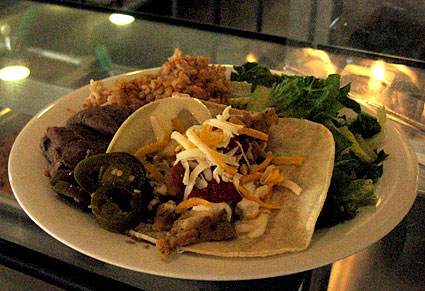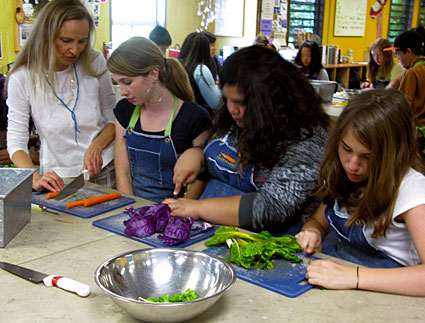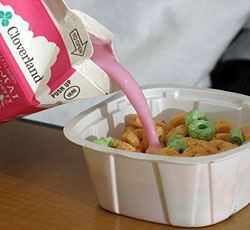 Typical breakfast in a DC public school(Ed Bruske photos)The conclusion of Cafeteria Confidential: Berkeley, in which Ed Bruske reports on his recent week-long, firsthand look at how Berkeley, Calif., schools part ways from the typical school diet of frozen, industrially processed convenience foods. Cross-posted from The Slow Cook.
Typical breakfast in a DC public school(Ed Bruske photos)The conclusion of Cafeteria Confidential: Berkeley, in which Ed Bruske reports on his recent week-long, firsthand look at how Berkeley, Calif., schools part ways from the typical school diet of frozen, industrially processed convenience foods. Cross-posted from The Slow Cook.
Might as well say it straight up: Kids don’t like vegetables.
At least most kids don’t like most vegetables most of the time. That’s the ultimate lesson I draw after spending weeks in school kitchens from Washington, D.C., to Berkeley, Calif. And that certainly challenges the idea of produce as a magic elixir for the childhood obesity epidemic. Is the clamor for additional government standards requiring more vegetables in school meals really justified, or even a good idea?
Truth to tell, I was relieved to see that students in Berkeley are just as indifferent to broccoli and carrots as kids everywhere else. There was a time I feared there might exist some kind of parallel universe in which children actually enjoyed and willingly ate the vegetables adults put in front of them. Perhaps the vision of children embracing collards and acorn squash is merely a case of wishful adult thinking after all.
What I saw during my week in Berkeley’s central school kitchen was a pair of seasoned, professional chefs who knew what the deal was with kids and vegetables. Being chefs on a budget, they take a clear-eyed, pragmatic approach to making school meals. They aren’t just slapping peas on a tray to satisfy some standard dreamed up in Washington, D.C. With stoic determination, they are finding ways to incorporate vegatables that would actually be eaten in daily meals, often by making them much less obvious. They don’t waste time or money on broccoli side dishes. They serve lots of beans, which satisfy government vegetable requirements cheaply and efficiently just in case that Tuscan bean salad ends up being scraped into the compost bin.
Why serve kids local Brussels sprouts if they just end up in the trash? That was exactly the message D.C. school officials sent legislators here when they tried to adopt new Institute of Medicine standards calling for bigger portions of vegetables: Please don’t!
In the District of Columbia, canned green beans, steamed carrots, and broccoli cooked to death appear on Styrofoam serving trays on a regular basis, only to be ignored by their taregt audience and trashed at the end of the meal. “They’re nasty,” is how my 10-year-old daughter and her classmates describe them. Isn’t the defininition of insanity repeating the same behavior over and over, expecting a different result?
 ‘Strawberry’ milk and sugary cereal are no way to start the dayThe chefs in Berkeley are sneaky. They load 125 pounds of fresh onions, carrots, and celery into every batch of marinara sauce they make for their pizza and pasta. Could the solution to our national angst over getting kids to eat more vegetables possibly be mirepoix? Or maybe what we need instead of more standards are some best practices that school kitchen managers can share.
‘Strawberry’ milk and sugary cereal are no way to start the dayThe chefs in Berkeley are sneaky. They load 125 pounds of fresh onions, carrots, and celery into every batch of marinara sauce they make for their pizza and pasta. Could the solution to our national angst over getting kids to eat more vegetables possibly be mirepoix? Or maybe what we need instead of more standards are some best practices that school kitchen managers can share.
Sweet and lowdown
The clamor for more produce in school meals also obscures a far simpler path to making school food healthier: We could improve it overnight just by getting rid of all the sugar served in the federally subsidized meal program.
Parents in Berkeley understand this. That’s why you don’t see the sugary cereals, cookies, Pop-Tarts and flavored milk in school breakfasts there that you do elsewhere. It’s a remarkable contrast to morning meals in D.C. schools, where kids consume 50 or 60 grams of sugar (as much as 15 teaspoons) first thing in the morning, and are offered strawberry-flavored milk — the near-equivalent of Mountain Dew — twice a day.
All schools need do is follow the lead of Berkeley and other school districts that understand that tons of sugar cannot be good for kids in the middle of an obesity epidemic. There is no reason to wait for the federal government to publish standards regulating the amount of sugar in school meals. In all likelihood, that won’t happen any time soon. The sugar lobby is strong. While there are volumes of standards regulating the fat content of school food, there are no such standards for sugar.
If anyone would like to start a campaign for rigorous sugar standards in the federal meals program, please have at it. I’ll be the first to support you.
More than anything, what this project has taught me is that standards really don’t make a fig of difference. What really matters is what kids see on their plate every day. We know that schools can serve industrially processed junk food full of starchy carbs and sugar that complies absolutely with federal standards. We know that kids, given a choice, will gladly eat that junk food. So how do schools make “healthy” affordable food kids will actually consume on the meager allowance the federal government gives them?
Berkeley succeeds because the city itself has invested in a great kitchen and in seasoned chefs to run it. They also get an enormous boost from the State of California and its “Meals for Needy” funding. How do you replicate something like Berkeley’s food service model across the country without a commitment to do so on the part of local communities and a huge infusion of cash?
 Made-from-scratch beef fajitas at a Berkeley school’s lunch, with a side of saladBecause I also teach kids about food and cooking on a regular basis, I know that children will eat vegetables in controlled situations in which they can handle and prepare the food themselves. That doesn’t mean they will eat every vegetable that comes down the pike. Sometimes they need to be exposed over and over again. Sometimes they will completely surprise me, as they did recently when they happily devoured an Ethiopian yellow split-pea stew we made for our classes.
Made-from-scratch beef fajitas at a Berkeley school’s lunch, with a side of saladBecause I also teach kids about food and cooking on a regular basis, I know that children will eat vegetables in controlled situations in which they can handle and prepare the food themselves. That doesn’t mean they will eat every vegetable that comes down the pike. Sometimes they need to be exposed over and over again. Sometimes they will completely surprise me, as they did recently when they happily devoured an Ethiopian yellow split-pea stew we made for our classes.
What was it that made that split-pea stew, seasoned with ginger, garlic, and curry spices, so appealing to grade-schoolers? Was it because we made it together and had so much fun in the process? Or was it because there were two teachers on hand, encouraging them? Would they have eaten that very same split-pea stew had it been offered in the cafeteria? It’s still a mystery to me. They also were crazy for an Ethiopian potato stew loaded with finely chopped cabbage and carrots. The parents out there know how hard it is to get the average kid to eat cooked cabbage or carrots.
Let them eat salad!
Something seems to come over kids when they enter a cafeteria. Even the ones trained in gardening and cooking will skip right past the vegetables to get to the pizza.
I happen to like the idea of salad bars. That runs somewhat counter to my reporting on school cafeterias. I’ve seen some lovely salad bars in schools, and most kids walk right past them. But I still like them and think they are worth pursuing. I’m told that in elementary schools, where children get more adult supervision and guidance around meal time, kids will eat from salad bars more enthusiastically. Properly done, I think salad bars are a great way to expose children to alternative approaches to vegetables and give them an opportunity to compose their own meals from a variety of food choices, including protein and dairy.
I propose, only partially in jest, a national program to put a salad bar in every school. Call it the National School Salad Bar Initiative. Not only would this expose every child to fresh vegetables in a pressure-free environment, it would create instant markets for local growers and provide jobs on a grand scale to retirees or others looking for part-time work. Berkeley employs special kitchen workers who spend three hours each day maintaining the salad bars that are installed in all 16 of the district’s schools. They tend to be elderly workers who don’t want to spend a lot of time on their feet.
It’s a perfect trifecta. A National School Salad Bar Initiative would also be a great way to support all the work Michelle Obama is doing fighting childhood obesity. Are you listening, President Obama? Salad bars are a perfect opportunity to make school food healthier, support local farmers, and put Americans back to work in hard economic times.



